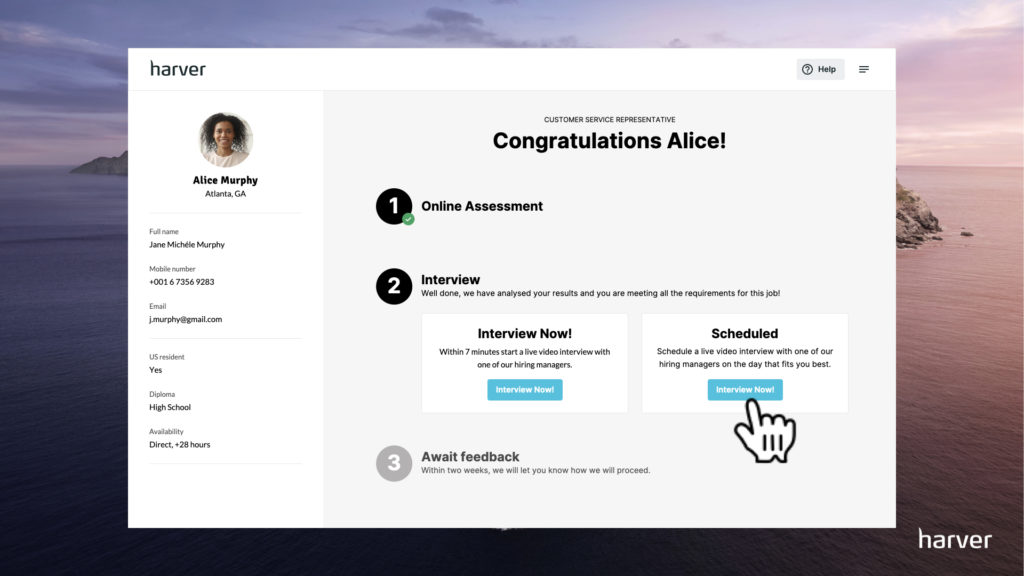Technology has revolutionized how hiring managers are able to screen candidates online, but structured interviews still have an important place in the recruitment process – even in volume hiring.
Behavioral interviews are a proven way to reveal certain candidate traits that would be difficult to show in virtual assessments or online screening.
When hiring hourly workers, many recruiters who are used to traditional hiring methods will rely too heavily on CVs and past experience when selecting the best candidates for their roles.
But resumes are never the best predictors of top performance for hourly worker roles in industries like retail, hospitality, and call centers. So instead of relying on what a candidate has put down on a piece of paper, adding a behavioral interview stage to your hiring process will give you much more insight into how a candidate is likely to perform if they’re hired into one of your roles.
What’s in?
Like what you see?
Don’t miss out. Subscribe to our quarterly digest to get the latest TA and TM resources delivered right to your inbox.
What is a behavior-based interview?
Behavior-based interviews are a structured traditional interview technique based on the idea that learning more about a candidate’s past performance will provide a clear and reliable picture of their future behavior in a new role.
In this kind of interview, the hiring manager will ask job candidates to provide a series of specific examples of how they’ve demonstrated certain knowledge, skills, abilities and other characteristics (known as KSAOs) that are required to be successful in the role they’re hiring for.
Behavioral interviews can be brought into the hiring process either as live, two-way interviews between the candidate and hiring managers (known as synchronous interviews) or they can be scheduled on-demand as a one-way digital interviewing option (known as asynchronous interviewing).
Whether you go down the route of synchronous or asynchronous interviewing in your volume hiring process, the idea is that asking behavioral interview questions will allow you to go beyond what the candidate can do to learn more about how they do it.

Types of behavioral interview questions
As with any type of interview, a successful behavioral interview relies heavily on good questions and providing each candidate with the same series of questions so that you provide a consistent experience for all interviewees.
There are three standard question types involved in behavior-based interviews. Here’s a breakdown of what they are and some examples of common behavioral interview questions:
Opening questions
As the name suggests, opening questions are used to provide a bit of context at the beginning of a job interview. They also give the candidate an opportunity to speak briefly about their experience and interest in the role.
Example opening question:
“Can you tell me a bit about your work background and how you think your experience relates to this role?”
Competency questions
Competency questions are used to pull together information on the candidate’s competencies in specific areas required in that role by asking them how they handle specific situations.
They are based closely on the job description to keep the interview highly relevant to the role and every candidate is asked the same questions to ensure they are all assessed on the same criteria. This makes the process fair for candidates and easy for recruiters to rate candidates against the requirements.
Example competency question:
“Can you give me an example of a time where you followed health and safety regulations in your last job? What happened and how did you know what to do?”
Follow-up questions
Follow-up questions are used to laser in on any areas where a candidate’s answer to a competency question has fallen short of what’s required to be successful in the role.
This could be that they have hesitated too long, given a vague or ambiguous answer, or perhaps they’ve given a good answer but one that suggests they didn’t entirely understand the question, meaning it can’t be scored against the criteria.
If a candidate’s answer to a competency question has highlighted a potential weakness, a follow-up question can give them the opportunity to explain how they overcome this potential weakness in the workplace.
These questions are not developed in advance but are based on the interviewer’s active listening and tailored to each individual candidate based on their answers.
Example follow-up questions:
“You mentioned that you prefer to work independently. What role do you think you play in situations that require teamwork?”
Best practices for behavioral interviews when volume hiring
If behavioral interviews are going to become a reliable and crucial stage in your volume hiring process, following best practice is everything.
As with any stage in the recruitment process, you need consistency across the board to provide a positive and fair candidate experience for every job seeker who goes through your process.
When you’re hiring hourly workers, it’s easiest to split best practices into three stages: preparation, interview, and making the hiring decision. Let’s take a look at the recommended best practice for each stage.
Stage 1: How to prepare for a behavior-based interview
Good behavioral interviews require some solid initial preparation for them to be successful. Here are some interview preparation guidelines for hiring managers.
Know the role inside out – For your behavioral interview to run smoothly and fairly, you need to know the role inside out. Go back to the role profile and familiarise yourself thoroughly with the requirements as well as the day-to-day of the job.
Even if you’re interviewing the candidate as a hiring manager and have hired for a role with the same job title before, don’t assume you know everything about the role. Take time to scrutinize the profile and job description so you know exactly who your organization is looking for in this new job.
Create questions using the STAR model – The result of this interview will depend almost entirely on your questions being fit for purpose. If you don’t ask questions that directly relate to the job profile and set the candidate up to cover the ground you need, you won’t get the answers you’re looking for.
This is where the STAR model can help when you’re creating behavior-based interview questions. The STAR method takes its name from an acronym for Situation, Task, Action, Results. This method ensures your questions cover all ground so the candidate knows what’s expected from them in their answer.
Here’s an example of a STAR question:
“Can you tell me about a time [Situation] where you faced a stressful situation at work? [Task] What did you do to handle this [Action] and what was the outcome? [Result]”
If you apply the STAR method to every interview question you create, you’ll get the kinds of answers that will make hiring decisions easy.

Test your questions – It’s a good idea to test your questions on current employees in the role you’re hiring for before you use them in a behavioral interview with candidates. How easy was the question to understand? Did the question lead to the interviewee providing an answer that tells a story about how they’d likely perform in future similar situations?
This is a great opportunity to review your questions and make edits wherever necessary to provide as much clarity as possible for candidates.
Review your candidate – Before you speak to any interview candidate, make sure you review any material you have on them. This will allow you to provide context and familiarise yourself with the candidate as an individual – especially when you’re interviewing a high number of candidates at once.
So for example, you could look closely at their application, their CV and work experience, LinkedIn profile and any pre-employment assessment results. However, if you’re using an assessment stage as part of your hiring process, it’s important to evaluate the candidate’s interview stage independently of their assessment results.
Know your interview tools and rating guides – Structured interviews are designed to create a fair and consistent experience for everyone, but this will only work if you ask the same interview questions and use the same candidate rating system across the board.
Before you begin any behavioral interview, always make sure you have confirmed how you will rate each candidate and that you have a solid understanding of what you’re evaluating.
Stage 2: How to behave during the interview
If you’re performing live two-way behavioral interviews that require you to be in attendance, whether online as a video interview or in person, there are a few best practice guidelines that will help you get the most out of your interviews.
Practice active listening – Active listening is a term used to promote, in a sense, better listening. It’s easy to slip into a habit of hearing candidates rather than really listening to what they have to say, and this can result in some candidates not getting a fair chance during job interviews.
So for example, when the candidate is talking about their past performance, focus carefully on what they are saying rather than thinking about what you want to ask them next.
To stay focussed, you can also try summarizing and repeating statements back to them to show you’re engaged and listening. This – along with providing positive signals like eye contact and head nodding – will show the candidate you’re engaged and create a positive interview environment for them.
Strike a balance with note-taking – Taking notes during interviews is all about balance: You want to detail enough information that will help you with your hiring decision later but at the same time continue to actively listen to the candidate’s answers rather than have your head in your notes.
The key here is to be open with the candidate about the fact you’ll be taking notes, and then document just enough information that will allow you to score them against your rating system immediately after the interview.
Stage 3: How to make the hiring decision
This final stage of the interview process can be the hardest part because it requires you to take accountability for a hiring decision. But if you follow these best practice guidelines, hiring your next job candidate shouldn’t be a difficult decision.
Use your rating resources – If you followed the best practice guidelines for stage one and created a solid rating system to use against each candidate, this takes the pressure off your own decisions.
Use the tools you have to objectively rate the candidate against the pre-decided criteria so you’re basing your decision purely on what will make them successful in the role, not whether you like the candidate or not.

Beware of common biases – Using a rating system will also help you avoid including any unintentional biases in your decision-making. Even when we don’t mean to, as interviewers we will have preconceived judgments about candidates based on our own experiences that can make interviews less objective.
Understanding and recognizing common biases is the first step to avoiding them, so familiarise yourself with common interview biases to reduce the chances of this happening.
Next steps
Behavior-based interviews are a great tool for candidate evaluation, and coupled with pre-employment assessments that provide objective data, they can help you in making better hiring decisions when recruiting for hourly roles.
Harver’s video interviewing solution allows you to bring asynchronous, pre-recorded interview stages into your volume hiring process without slowing down time-to-hire. If you’d like to take a closer look at our solution, you can book a demo below.
Ready to transform your hiring process?


